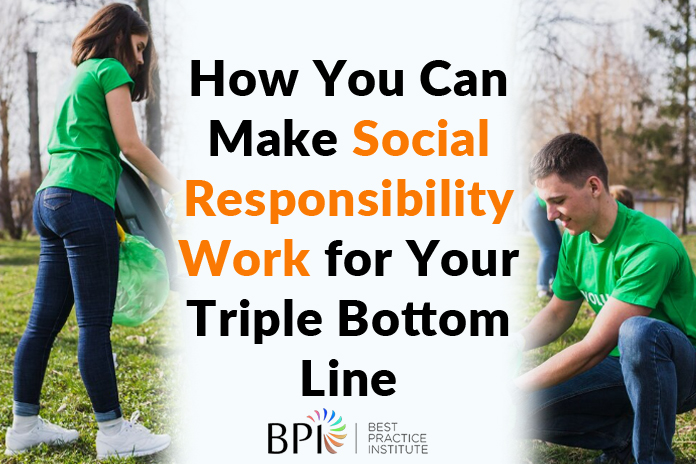In today’s dynamic business landscape, where success extends beyond mere financial gains, the Triple Bottom Line (TBL) has emerged as a pivotal framework. This approach, encompassing profit, people, and the planet emphasizes the interconnectedness of economic, social, and environmental considerations.
To truly make the Triple Bottom Line work for your organization, it is essential to delve into corporate social responsibility (CSR), sustainable practices, and impactful social initiatives. Let’s explore practical strategies to enhance your TBL by weaving social responsibility into its fabric.
Understanding the Triple Bottom Line
The TBL, introduced by John Elkington, encourages businesses to move beyond a singular focus on profits. In the TBL framework, profit is intricately linked with two other critical dimensions: people and the planet. Profit becomes meaningful without compromising individuals’ well-being or the environment’s health.
Corporate Social Responsibility as a Pillar
At the heart of making social responsibility work for your Triple Bottom Line is a robust Corporate Social Responsibility (CSR) strategy. CSR holds organizations accountable for the societal impacts of their actions, aligning seamlessly with the TBL’s emphasis on people and the planet. Your CSR initiatives should extend beyond philanthropy to encompass sustainable practices, ethical considerations, and community engagement.
Sustainable Practices Driving Environmental Impact
Sustainability practices form a cornerstone of the Triple Bottom Line, explicitly addressing the ‘planet’ component. Adopting eco-friendly measures in your operations, supply chain, and product lifecycle contributes to a positive environmental footprint. It might include commitments to reduce carbon emissions, lower waste, and promote the use of renewable resources.
Case Study: Apple’s Commitment to Carbon Neutrality
Apple stands as a prime example of a company intertwining sustainability with profitability. They want to be carbon neutral by 2030, which exemplifies a commitment to the ‘planet’ aspect of the TBL. By prioritizing the environment’s well-being, Apple showcases how sustainable practices can be integral to a company’s long-term success.
Social Impact Initiatives Fostering Community and Employee Well-being
Engaging in social impact initiatives is another avenue to strengthen the ‘people’ dimension of the Triple Bottom Line. These initiatives extend beyond the workplace to encompass the communities in which your organization operates. Prioritizing employee well-being, diversity and inclusion, and community development contribute positively to the overall social fabric.
Case Study: Ben & Jerry’s Mission Beyond Ice Cream
Ben & Jerry’s, renowned for its delectable ice cream, takes social responsibility to heart. Their mission extends beyond crafting indulgent flavors; it encompasses a commitment to wholesome, natural ingredients and business practices that care for the Earth and the environment. It demonstrates how a brand’s dedication to social impact can resonate with consumers.
Integrating Social Responsibility Metrics into Performance Evaluation
To truly embed social responsibility in the DNA of your Triple Bottom Line, consider integrating relevant metrics into your performance evaluation systems. Beyond financial KPIs, include:
- Indicators that gauge your environmental impact.
- The success of social initiatives.
- Adherence to ethical practices.
When success is measured by financial achievements and positive contributions to the environment and society, employees are motivated to align their actions with broader organizational values.
This cultural shift reinforces the understanding that each employee, irrespective of their role, is part of advancing the organization’s commitment to the Triple Bottom Line. It goes beyond compliance and transforms into a shared responsibility to contribute to a sustainable and socially conscious business model.
As social responsibility becomes integral to performance expectations, employees are more likely to champion initiatives that align with these values, creating a ripple effect that extends the impact of the organization’s commitment far beyond the boardroom.
Best Practices: Metrics for Triple Bottom Line
1. Environmental Impact Metrics:
- Measure and report on your organization’s carbon footprint, energy consumption, and waste reduction initiatives.
- Implementing comprehensive environmental impact metrics involves quantifying the organization’s ecological footprint. Tracking the carbon footprint provides insights into greenhouse gas emissions, fostering awareness for targeted reductions. Additionally, evaluating energy consumption and waste reduction initiatives helps streamline resource usage, contributing to a more sustainable operational model.
2. Social Initiatives Metrics
- Track the success of social impact programs, employee well-being indicators, and community engagement metrics.
- Assessing the impact of social initiatives requires a multi-faceted approach. Employee well-being indicators encompass job satisfaction, mental health support, and work-life balance. Monitoring community engagement metrics involves measuring the positive influence on local communities through initiatives such as volunteer programs or partnerships. By systematically tracking these metrics, organizations can tailor their social strategies for maximum positive effect.
3. Ethical Practices Metrics:
- Evaluate adherence to ethical standards through metrics like supply chain transparency, fair labor practices, and diversity and inclusion indices.
- Ethical practices are foundational to the Triple Bottom Line, and metrics ensure accountability. Supply chain transparency metrics assess the visibility into the production process, fostering responsible sourcing. Fair labor practices metrics gauge compliance with ethical labor standards, and diversity and inclusion indices measure progress in creating an equitable workplace. Regular evaluation using these metrics supports a corporate culture rooted in ethical responsibility.
Challenges and Solutions in Executing Social Responsibility for the TBL
While the benefits of integrating social responsibility into the Triple Bottom Line are evident, businesses often face challenges. These may include a need for standardized frameworks for CSR reporting, difficulties in benchmarking against industry peers, and technology solutions to streamline data collection and reporting.
Overcoming Challenges: Diligent’s ESG Solutions
Diligent’s ESG solutions address these challenges by providing up-to-date information on ESG standards, facilitating benchmarking, and ensuring governance intelligence. Leveraging technology in social responsibility initiatives can streamline reporting processes and enhance transparency.
Final Word
Making social responsibility work for your Triple Bottom Line is not just a corporate responsibility but a strategic imperative. By seamlessly integrating CSR, sustainable practices, and impactful social initiatives, your organization can elevate its commitment to the TBL, contributing to a more sustainable and equitable world.
As you embark on this journey, consider taking a bold step to distinguish your organization. Apply to become a Newsweek’s Excellence 1000 Company, showcasing excellence in sustainability, ethical practices, customer service, and your specific industry.
Becoming a top company in social responsibility is a recognition and a testament to your dedication to creating a positive impact beyond financial gains. Embrace the Triple Bottom Line with a commitment to social responsibility, and position your organization as a leader in the evolving landscape of conscientious business practices.










